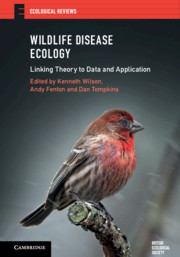Book contents
- Wildlife Disease Ecology
- Ecological Reviews
- Wildlife Disease Ecology
- Copyright page
- Contents
- Contributors
- Preface: Wildlife Disease Ecology
- Glossary of Terms
- Part I Understanding within-host processes
- Part II Understanding between-host processes
- Part III Understanding wildlife disease ecology at the community and landscape level
- Chapter Fifteen The ecological and evolutionary trajectory of oak powdery mildew in Europe
- Chapter Sixteen Healthy herds or predator spreaders? Insights from the plankton into how predators suppress and spread disease
- Chapter Seventeen Multi-trophic interactions and migration behaviour determine the ecology and evolution of parasite infection in monarch butterflies
- Chapter Eighteen When chytrid fungus invades: integrating theory and data to understand disease-induced amphibian declines
- Chapter Nineteen Ecology of a marine ectoparasite in farmed and wild salmon
- Chapter Twenty Mycoplasmal conjunctivitis in house finches: the study of an emerging disease
- Chapter Twenty-one Processes generating heterogeneities in infection and transmission in a parasite–rabbit system
- Chapter Twenty-two Sylvatic plague in Central Asia: a case study of abundance thresholds
- Index
- Plate Section (PDF Only)
- References
Chapter Twenty-one - Processes generating heterogeneities in infection and transmission in a parasite–rabbit system
from Part III - Understanding wildlife disease ecology at the community and landscape level
Published online by Cambridge University Press: 28 October 2019
- Wildlife Disease Ecology
- Ecological Reviews
- Wildlife Disease Ecology
- Copyright page
- Contents
- Contributors
- Preface: Wildlife Disease Ecology
- Glossary of Terms
- Part I Understanding within-host processes
- Part II Understanding between-host processes
- Part III Understanding wildlife disease ecology at the community and landscape level
- Chapter Fifteen The ecological and evolutionary trajectory of oak powdery mildew in Europe
- Chapter Sixteen Healthy herds or predator spreaders? Insights from the plankton into how predators suppress and spread disease
- Chapter Seventeen Multi-trophic interactions and migration behaviour determine the ecology and evolution of parasite infection in monarch butterflies
- Chapter Eighteen When chytrid fungus invades: integrating theory and data to understand disease-induced amphibian declines
- Chapter Nineteen Ecology of a marine ectoparasite in farmed and wild salmon
- Chapter Twenty Mycoplasmal conjunctivitis in house finches: the study of an emerging disease
- Chapter Twenty-one Processes generating heterogeneities in infection and transmission in a parasite–rabbit system
- Chapter Twenty-two Sylvatic plague in Central Asia: a case study of abundance thresholds
- Index
- Plate Section (PDF Only)
- References
Summary
Infection severity and persistence in a host population is affected by variation in host susceptibility. External disturbance can exacerbate/reduce individual variation by affecting the interactions between the host and its parasites and the dynamics of infection and transmission. We investigated the impact of three sources of disturbance (climate change, the presence of a second parasite species and anthelmintic treatment) on the dynamics of infection and shedding of three common parasites of the rabbit. Data were collected from long-term field studies and laboratory experiments and analysed using mathematical modelling and analytical tools. Our studies show that they all affect host–parasite interactions by altering the intensity of infection and/or the degree of parasite shedding. They also generate patterns of infections that could not have been predicted in the absence of these disturbances or from performing analyses at a different temporal scale. Modelling simulations confirmed the complexity of the processes involved and identified the critical interactions shaping the patterns observed.
Keywords
- Type
- Chapter
- Information
- Wildlife Disease EcologyLinking Theory to Data and Application, pp. 598 - 622Publisher: Cambridge University PressPrint publication year: 2019

